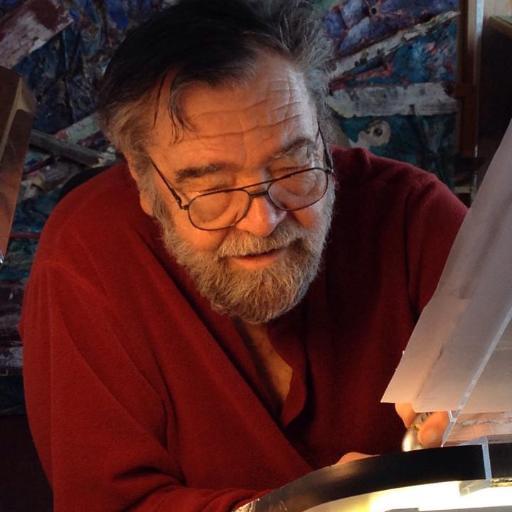 Tim here with as big a story as animation is apt to produce: Ralph Bakshi will debut Last Days of Coney Island on Vimeo on October 29th, on his 77th birthday no less. It's his first animated project since a pair of short films in 1997.) This makes the second time in 2015 that a triple-A Animation God has used that platform to show the world his newest project. (The first was Don Hertzfeldt's World of Tomorrow in March; but as much as we should all of us love and adore Hertzfeldt and his work, there's no comparing his prominence in the animation ecosystem to that of Bakshi, a figure who earns every bit of the phrase "living legend".)
Tim here with as big a story as animation is apt to produce: Ralph Bakshi will debut Last Days of Coney Island on Vimeo on October 29th, on his 77th birthday no less. It's his first animated project since a pair of short films in 1997.) This makes the second time in 2015 that a triple-A Animation God has used that platform to show the world his newest project. (The first was Don Hertzfeldt's World of Tomorrow in March; but as much as we should all of us love and adore Hertzfeldt and his work, there's no comparing his prominence in the animation ecosystem to that of Bakshi, a figure who earns every bit of the phrase "living legend".)
I write these words as a person who, confessedly, doesn't have much affection for Bakshi's output. Still, it's impossible not to be curious what the mind behind the most visible underground animation in history has up his sleeve, now that the 21st Century and digital distribution have come around to offer him new avenues to showcase his art.
I'd like to share a short primer of the offbeat corners that the always-ambitious, frequently hapless auteur has explored in his 43-year career (after the jump)
The Best: American Pop (1981)
Fritz the Cat is obviously better-known and made a far bigger splash when it was new, but I wouldn't hesitate for an instant in picking this as Bakshi's most successful, important, smart work.
It's a multigenerational epic in which a Russian-Jewish boy immigrates to 1890s New York and finds himself falling in with burlesque performers. This triggers a lifelong fascination with performing music that he passes on to his son, grandson, and great-grandson, in the process allowing Bakshi to trace the history of American popular music from the 19th Century all the way to '80s New Wave, with a lingering stopover in the '60s counterculture that has more nuanced criticism and love of that scene than anything in the snarling, snotty Fritz.

It's not the most visually audacious film Bakshi oversaw, but it's a perfect snapshot of things that animation, and only animation can accomplish. Time skips ahead, boys age to men and senior citizens in moments, the physical space of Bakshi's worshipfully rough-hewn New York evolves in scuffed-up drawings that change style without ever gaining unneeded polish. It's thoroughly confident in its grandeur its use of a single family drama to narrow that grandeur to a manageable scale. It's hard to scrounge up, but if you manage to do it, you'll be rewarded with one of the truly exceptional works of animation in the 1980s.
The Worst: Cool World (1992)
In this universe, we get to look on this as the concept that Bakshi had ripped away from him and transformed into something only vaguely resembling his original notion, and bemoan the corporate compromise of a singular, if utterly daft vision. Perhaps in some other universe, they got that singular vision and bemoan the lack of sensible oversight that would have tamed its astonishingly off-putting extremes. Because in every case, the basic hook – what if they remade Who Framed Roger Rabbit, only the whole thing hinged on cartoons having sex with real-life people? – is deranged no matter what.

It's ugly and garish, but not ugly and garish enough, if that makes sense: the crude animation and aimless visual gags are irritating without feeling particularly dangerous, while the grotty backgrounds are unpleasant enough to be off-putting, but fall short of true madness. It also suffers from a bit of circular casting: Bakshi wanted Brad Pitt for the lead role that went to Gabriel Byrne, with Pitt instead getting dropped into a supporting character who is then given more emphasis than Byrne's, until the plot forcibly snaps back into shape (both parts were live action; Kim Basinger completes the trio as a cartoon woman who turns human partway through). It's a repulsive, cruel-minded failure of storytelling at any level, but it's also probably the most unique English-language animated feature of the '90s. You win some, you lose some.
The Battiest: Fire and Ice (1983)
The third of Bakshi's fantasy films (following 1977's Wizards and 1978's titanically misbegotten The Lord of the Rings) is a collaboration with legendary genre fiction cover artist Frank Frazetta that does a surprisingly good job of bring Frazetta's largely impossible worlds – especially his largely impossible feminine bodies – to something like life. Even the stiffness that attends to most of Bakshi's works plays better here than in his other fantasies: the blunter, thicker barbarian violence in this film compared to the misfiring high fantasy of The Lord of the Rings is suited to the limitations of its budget.

Thoroughly juvenile, strangely tongue-in-cheek, and enthusiastic about the clichés it juggles in its baffling plot, the film is broad and dopey but also devoid of an self-doubt. It's an especially hallucinatory entry to the '80s sword-and-sorcery cycle, and probably the weirdest movie in Bakshi's career – weirder than the cartoon/human sex noir, yes. It's so proud of being itself, whatever the hell that is, that I have to consider one of his most engaging successes even if everything about it feels hopelessly wrong.
